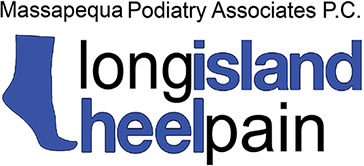Achilles tendinitis (or tendonitis) causes heel pain when the tendon—also called the heel cord—connecting your calf muscle to your heel becomes inflamed. You might first notice symptoms such as mild pain and stiffness in the back of the heel that are usually worse in the morning and following physical activity. Tenderness, swelling, redness, and warmth are additional symptoms of Achilles tendinitis. Running, jumping, and even walking often intensify pain, and you might even find it harder to perform daily activities.
At Massapequa Podiatry Associates, our board-certified Long Island heel pain specialists provide extracorporeal shockwave therapy (ESWT) to treat Achilles tendinitis and other foot and ankle conditions. This and other cutting-edge medical interventions are often able to prevent our patients from needing surgery.
Table of Contents
- Major Risk Factors for Achilles Tendinitis
- 7 Tips To Prevent Achilles Tendinitis and Improve Foot Health for Athletes
- How Shockwave Therapy Can Help Treat Achilles Tendinitis?
- What Our Patients Like About Shockwave Therapy
- Is Shockwave Therapy Right for You?
- Questions Our Long Island Podiatrists Can Answer
Major Risk Factors for Achilles Tendinitis
 Nearly a quarter of athletes injure their Achilles tendon at some point. Achilles tendinitis is often an overuse injury, which means it is more likely to impact people who exert a lot of effort with their feet and ankles, such as:
Nearly a quarter of athletes injure their Achilles tendon at some point. Achilles tendinitis is often an overuse injury, which means it is more likely to impact people who exert a lot of effort with their feet and ankles, such as:
- Athletes who play sports with a lot of starts and stops
- Runners
- Dancers
- Laborers whose jobs require them to spend a lot of time on their feet without breaks
- People who only participate in sports occasionally but push their bodies too hard when they’re active
Certain body characteristics can also increase the risk of developing this condition, including, but not limited to:
- Tight or weak calf muscles
- Bone spurs
- Flat arches
- Overpronation
Additionally, some people put more strain on the tendon if they wear unsupportive shoes, fail to warm up properly, or exercise on uneven surfaces.
7 Tips To Prevent Achilles Tendinitis and Improve Foot Health for Athletes
At Massapequa Podiatry Associates, we encourage all our patients to adapt different routines and lifestyle factors if necessary to promote better foot health. Here are some of our recommendations:
- Warm up before you work out. Be sure to thoroughly stretch your calf muscles and do ankle rotations to improve the joint’s range of motion.
- Cross-train so you’re not always doing exercises that put stress on your Achilles tendon. Rotating between your preferred sport and low-impact activities such as swimming and cycling helps you stay in shape while giving your feet and ankles a break.
- When you want to increase the length or intensity of your workouts, make gradual changes. Never increase the amount you push your body during workouts by more than 10 percent per week.
- Stay in shape year-round, not just when it’s the season for your preferred sport.
- Make sure to choose the right kind of athletic footwear for each specific activity—running shoes for jogging, high-ankle supportive shoes for basketball, and so on.
- Don’t exercise on hills all the time. Use flat surfaces as your primary training ground and gradually build up leg strength and endurance with occasional hill work.
- Listen to your body and stop if you experience pain.
How Shockwave Therapy Can Help Treat Achilles Tendinitis?

Our office is pleased to offer a wide array of interventions for Achilles tendinitis treatment, including state-of-the-art Extracorporeal Shockwave Therapy (ESWT).
Shockwave therapy is a form of regenerative medicine that helps your body to heal itself without using pharmaceuticals.
Much like an ultrasound, ESWT is administered through a handheld device over a gel applied to the skin. Sound waves penetrate the skin, entering the damaged tissue, which leads to:
- Helping new blood vessels to form
- Increased blood flow
- Bread down of calcifications
- Temporary reduction of the neurotransmitters that send pain signals to the brain
- Accelerated tissue repair
- Reduced inflammation
- Faster recovery
Recent studies of ESWT found that pain and function generally improve following ESWT, particularly when it’s combined with other nonsurgical treatments, such as lifestyle modifications, orthotics, and other solutions.
While some patients experience minor discomfort during their sessions, most report that the procedure feels similar to a rubber band being snapped against the skin. Mild pain, tingling, and bruising sometimes occur following ESWT, but complications are rare, and
Patients generally find that shockwave therapy improves their mobility and quality of life.
What Our Patients Like About Shockwave Therapy
Explore the benefits of the ESWT treatment option, and it's one many of our patients at Massapequa Podiatry Associates prefer because it’s:
- Non-invasive—no anesthesia, injections, or surgery are required
- Safe and FDA-approved
- Highly effective in treating Achilles tendinitis and other issues that can cause heel pain
- Quick—most sessions usually last only 5–10 minutes, are usually scheduled around a week apart, and the effects last for several weeks
- No risk of drug interactions
Because ESWT is actually fixing the problem and not just alleviating the symptoms, most of our patients experience long-lasting results after just a few sessions.
Is Shockwave Therapy Right for You?
Our Long Island heel pain specialists work with you to create an individualized treatment plan for quality care. This requires:
- A thorough physical examination
- Discussing your health history, recent activities, and symptoms
- Observing your range of motion
Imaging tests such as ultrasound, MRI, or X-rays may also be helpful to determine the severity of the problem and ensure we implement the most effective treatment.
We generally start with the most conservative measures when treating conditions. These may include:
- Rest, giving your tendon a chance to heal on its own.
- Icing the injury, such as with an ice pack, applied for 20 minutes at a time, several times a day to reduce inflammation and pain.
- Compression, such as wrapping your foot or ankle in an elastic bandage.
- Elevation, which involves keeping your foot raised above the level of your heart while seated.
- Custom orthotics, as shoe inserts may help reduce the impact on your tendon.
- Over-the-counter pain relievers, which help lessen pain and swelling.
- Activity modification, such as changing your exercise routine or performing certain activities differently.
- Physical therapy, as certain stretches and exercises that focus on releasing calf muscles and improving foot mobility are often especially beneficial.
- Immobilization with a boot or other device, which may reduce the load on the tendon and allow healing to happen more quickly.
If more conservative treatment options don’t work, our next recommendation might be shockwave therapy for your Achilles tendinitis. However, ESWT might not be a good option for some patients, including those who are pregnant or who have:
- Certain blood clotting disorders
- Serious heart conditions
- Seizure disorders
- Infections
Trust that our Massapequa foot doctors have many other advanced treatments for foot pain designed for your specific needs and lifestyle. Explore our client testimonals that often highlight our thorough, compassionate care and exceptional service is exactly what they hope for to address different foot health issues.
Questions Our Long Island Podiatrists Can Answer
Remember: pain is never “just the way it is.” Schedule a consultation in our office if:
- You have heel pain that doesn’t go away within a few weeks
- Your heel pain is severe
- You heard a popping sound at the time of your injury, or you heard “crackling” in the ankle since the incident.
At Massapequa Podiatry Associates, you should have full confidence that by the end of your examination, we’ll be able to tell you:
- If you have Achilles tendonitis.
- What you can do to keep your injury from getting worse.
- If your tendon is ruptured.
- Which nonsurgical treatment options do we recommend?
- If you’re likely to need surgery.
- How long do we expect your recovery to take?
- Activities you should avoid while you’re healing.
- If there are medications that could help reduce your pain.
Unfortunately, this isn’t a problem you can ignore. Not treating Achilles tendinitis may result in a tendon rupture, which often requires surgery to resolve. One of our primary goals in our Long Island office is to help our patients avoid surgery. Shockwave therapy might be the answer for you—talk to us about its potential to aid your healing.

